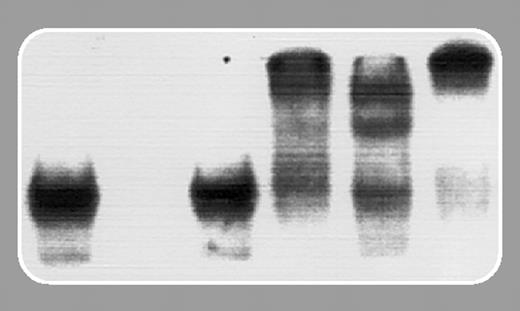The 39 members of the HOX homeobox gene family are organized in 4 paralogous clusters of 8 to 11 genes. HOX genes encode DNA-binding proteins that are deployed in overlapping domains along various body axes during embryonic development. This sequential activation of HOX genes in time and space, the “HOX clock” if you will, generally proceeds in a 3′ to 5′ direction within a given cluster and is critical for the proper positioning of structures along those axes, which include the vertebrae, the limbs, and the gastrointestinal and genitourinary tracts.
Many HOX genes from the HOXA and HOXB clusters are active in primitive hematopoietic cells, tissues not thought to have an axis. HOX genes are important in hematopoiesis, as certain HOX knock-out mice have defects in blood cell development. Conversely, enforced overexpression of individual HOX genes in marrow cells results in marked expansion of hematopoietic stem cells. With the exception of HOXB4, this stem cell expansion is accompanied by progression to myeloid leukemia. The favorable effects of HOXB4 on stem cells have attracted great interest in its potential therapeutic utility in marrow transplantation and gene therapy. Key questions are what role HOXB4 plays in normal stem cell function and how this gene is regulated in hematopoietic cells.FIG1
Kirito and colleagues (page 3172) report that thrombopoietin (TPO) increases HOXB4 expression in hematopoietic cell lines and, conversely, that TPO-deficient primitive marrow cells have reduced HOXB4 levels. They provide evidence that TPO activates HOXB4 via a p38-dependent pathway involving the upstream stimulating factor 1 (USF-1) transcription factor. These data suggest that the effects of TPO on stem cell expansion are mediated in part by HOXB4. The TPO-induced up-regulation of HOXB4 in cell lines is modest—only 2- to 3-fold; however, this magnitude of up-regulation was shown by other investigators, using retroviral vectors to increase HOXB4 expression, to be sufficient to expand stem cells. These findings must be qualified by the fact that the magnitude of the stem cell defect in TPO-deficient mice is much greater than in HOXB4-deficient animals, suggesting that TPO's salutary effects on stem cells involve other downstream targets, perhaps including other HOX family members. Although Kirito et al show that TPO does not up-regulate the HOXA9 gene, it is possible that it activates other HOXB4 paralogs, such as HOXA4 and HOXC4.
It is difficult to reconcile how HOX genes play a role in such disparate activities as limb development and hematopoiesis. One speculation is that HOX proteins function as timers or sequencers for complex differentiation processes. In this model, different developmental programs use the HOX clock to order maturational events specific for that tissue. In one study, the GATA-1 transcription factor was shown to regulate the HOXB2 gene in erythroid cell lines, suggesting another pathway by which HOX genes could be activated in blood cells. It seems likely that other hematopoietic cytokines that influence stem cell proliferation also regulate HOX gene expression. Does the hematopoietic system have an axis? Only a more careful delineation of HOX protein expression in marrow cells will answer that question.


This feature is available to Subscribers Only
Sign In or Create an Account Close Modal